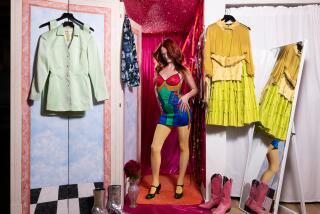Hollywood’s Catalogue Caper
- Share via
Robert Redford, actor, is also Robert Redford, retailer.
You won’t find him minding the country store at his Sundance, Utah, spread, sorting Western vests or buffing Zuni rings. But you will find his likeness, his name and his encouraging words on the 4 million four-color, recycled paper catalogues that are in the mail.
Redford is alone among Hollywood’s stars with a catalogue to his credit.
He is not alone in the great November rush to sell us something that comes from someone or someplace special.
We are a nation of logomaniacs.
We drink from Mickey Mouse mugs and dress in Terminator T-shirts and Daffy Duck denims.We decorate our walls with prints and posters that come with famous names from brand-name museums.
Almost every large-budget movie in Hollywood’s year-end selling frenzy will have something extra going for it in the form of merchandise. It’s another way of keeping the name of the movie in front of us while putting something into the studio’s vaults . . . maybe. Universal’s “An American Tail: Fievel Goes West” has lined up a reported 40 product-licensees. Paramount’s “The Addams Family” has at last count 20 deals for bangles, baubles and breakfast foods.
CNN is testing the waters of retail commerce, licensing its logo, opening a test store, working a tie-in with a shoe-store chain.
A growing number of entertainment companies aren’t waiting for you to get to the mall. They’re going after you in the mail.
The Walt Disney Co. started a retail store operation four years ago and more recently swung into the mail-order business, delivering 48 pages of “Enchanted Collectibles” and “Mickey Magic.” Warner Bros. expanded its studio store operation also about four years ago, including a catalogue that in its 52 pages sells Robin Hood jackets, Superman nightshirts, and Sylvester and Tweety books among other national treasures.
NBC has a line of “Cheers,” David Letterman and “Santa Barbara” gadgets (the ever-constant mugs and T-shirts) that it sells through its three retail stores and through a mail-order arrangement with its affiliate stations. A much smaller broadcaster, Minnesota Public Radio, found out several years ago that public support could also come through catalogues. It has two offerings, “Wireless” and “Signals,” selling the usual assortment of logo adornments, audio cassettes and books. PBS, however, opened and then had to close its catalogue operation for its affiliate stations, yet hopes to return some day to a catalogue operation with its potential for revenues.
That search for additional moneys is the driving force behind these new catalogue operations. But it’s a risky business requiring years of development and expensive gambles. Most catalogue operations take three to five years to show profits. Even with mailings into the millions the return of sales is usually in the 1% to 3% range.
In some cases, the return on investment is more than just money in the bank.
So we return to Robert Redford, retailer. The Sundance catalogue, now winding up its first full year of operation, is designed to do a couple of things besides move the merchandise. It will financially help support the expanding arts and cultural programs at the Sundance Institute in Utah, its summer theater programs, its film festival, its ongoing educational and arts training programs--a $2-million annual venture.
Redford has provided start-up funds for the catalogue and profits from sales at the Sundance store and the catalogue will go toward these programs. The long-range hope is a $10-million endowment for the institute. As one executive explained it: “We are creating something that will live beyond Bob.”
The catalogue also provides an outlet and income for artists and crafts people. Most of the items--jewelry, clothing, furnishings--are commissioned and individually produced, and according to company officials, they have to be of environmentally safe products. Handmade is the rule at the Salt Lake City offices of Sundance Catalog Co.
Gary Beer, president of the Sundance Group and its free-standing catalogue company, admits to feeling like Henry Ford starting an industry. He’s “very pleased” with the 2% to 3% returns so far in what he calls a “start-up operation.”
“This is not a licensing deal. This is Robert Redford’s company,” he says. “It’s his creation and it’s his philosophies that are involved with it. We’ve had inquiries from agents and managers of other celebrities. When we explain all of the details they lose interest.”
Then there’s the godparent of all arts and entertainment catalogues, the one that has been mailed from the Metropolitan Museum of Art in New York for 70 years, although there’s been a catalogue there since 1901 for members only. (The museum was in the retail business before it opened in 1871, publishing and selling in 1870 a portfolio of reproductions.) The museum’s big fall mail-order catalogue--greeting cards, reproductions, jewelry, calendars--runs to 148 pages. It’s but one of seven catalogues, all smaller, of specialized interest, produced by the museum each year.
Certainly, income is a reason for the catalogue’s existence along with its retail operations in the United States and Japan, perhaps a stronger reason than ever considering the economy in general.
Brad Kelleher has been with the museum since 1949 and is now a consultant in publishing and merchandising. He sees other compelling reasons for the catalogue: It provides a cultural message, it helps spread awareness of the arts, it provides commissions for the many artists who produce exclusively for it.
The entire resources of the museum’s 3 million works are available for the catalogue operation. The museum’s 18 curatorial departments serve as consultants with veto powers in the selection of merchandise. Reproductions and original works are usually done in museum facilities.
The museum’s catalogue mailings run to 4 million, somewhat up from the 25,000 that went out 40 years ago. Catalogue sales provide a net of $2 million for the museum’s $80-million annual budget. Part of the expenses of many scholarly and clearly nonprofit projects and publications are supported by the museum’s retail sales.
It’s taken years and major investments for the Met to develop these projects, as it has for other museums with extensive catalogue operations--the Smithsonian, the Boston Museum of Fine Arts, the Chicago Arts Institute. Our locals, such virtual newcomers to the business as the Los Angeles County Museum of Art and MOCA, have minor mail-order enterprises. LACMA occasionally offers posters and gift-store items through mailings, the last a 12-page catalogue.
Others--from TV networks and movie studios to museum gift shop operators--also are brushing up on their postal regulations and considering turning to catalogue sales. There are, after all, so many millions out there.
More to Read
Inside the business of entertainment
The Wide Shot brings you news, analysis and insights on everything from streaming wars to production — and what it all means for the future.
You may occasionally receive promotional content from the Los Angeles Times.










